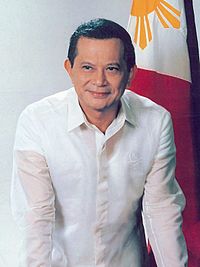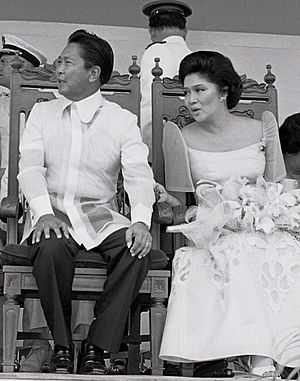Prime Minister of the Philippines facts for kids
Quick facts for kids Prime Minister of the Philippines |
|
|---|---|

Prime ministerial standard (1981–1986)
|
|

Prime ministerial seal (1981–1986)
|
|
|
|
| Style | Prime Minister (informal) The Honorable (formal) His Excellency (formal, diplomatic) |
| Member of | Cabinet |
| Nominator | The President |
| Appointer | The President (1899) Batasang Pambansa with members' advice and consent (1978–1986)
|
| Precursor | Office established (pre-1899) President of the Philippines (1978) |
| Formation | January 2, 1899 (first creation) June 12, 1978 (second creation) |
| First holder | Apolinario Mabini (first creation) Ferdinand Marcos (second creation) |
| Final holder | Pedro Paterno (first abolition) Salvador Laurel (second abolition) |
| Abolished | November 13, 1899 (first abolition) March 25, 1986 (second abolition) |
| Succession | Deputy Prime Minister (1978–1986) |
The Prime Minister of the Philippines (Filipino: punong ministro ng Pilipinas) was a very important leader in the Philippines. This person was the head of the government, meaning they were in charge of running the country's daily affairs. The President of the Philippines was the head of state, representing the country.
The role of Prime Minister existed from 1978 until 1986. During this time, especially under martial law, the Prime Minister also led the Armed Forces of the Philippines. Before this, a similar position, called the President of the Council of Government, briefly existed in 1899 during the First Philippine Republic.
Salvador Laurel was the last Prime Minister. He held the role from February 25 to March 25, 1986. He was also the first Vice President after martial law ended. After March 1986, he continued to serve only as Vice President until 1992.
Contents
History of the Prime Minister Role
First Creation (1899)
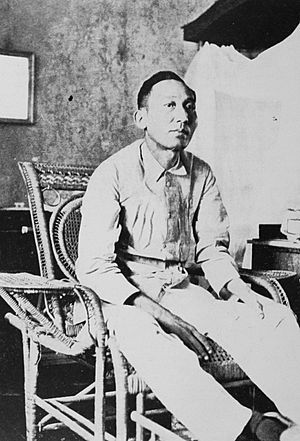
The 1899 Constitution of the Philippines created a group called the Council of Government. This council had a President and seven secretaries. On January 2, 1899, Emilio Aguinaldo, the president of the revolutionary government, chose his advisor Apolinario Mabini to be the first President of the Council of Government. Mabini also served as the country's finance minister. This role was basically the same as a Prime Minister.
At this time, the Spanish–American War had just ended. Spain gave up its control over the Philippines to the United States. However, the Philippines had already declared its independence on June 12, 1898. The United States did not agree that the Philippines was an independent country. This disagreement led to conflict when the First Philippine Republic was officially formed on January 23, 1899.
Mabini faced many political challenges, especially trying to make peace between Filipino and American forces. When talks failed, the Philippine–American War began on February 4, 1899. The government had to move from place to place to avoid the fighting. Mabini, facing pressure from his political rivals and the ongoing war, left his position on May 7, 1899.
One of Mabini's rivals was Pedro Paterno. He was the president of the Malolos Congress. Paterno wanted to make peace with the Americans, even if it meant the Philippines would become a protectorate of the United States. Mabini disagreed, but Paterno and his allies convinced Aguinaldo to remove Mabini from his role.
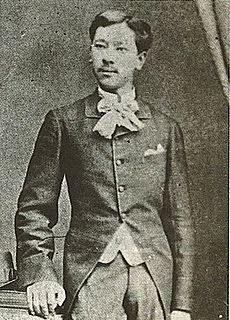
On May 8, Aguinaldo appointed Paterno as the new President of the Council of Government. Paterno immediately tried to make a peace deal with the U.S. government. He suggested that Filipinos would give up the idea of full independence and accept U.S. rule.
However, General Antonio Luna, a top military leader, was very angry about Paterno's actions. He tried to arrest Paterno and other cabinet members, but he failed. Because of this, Paterno had to declare war against the United States on June 2, 1899. A few days later, on June 5, Luna was killed. Some believe his conflict with Paterno was a reason for his death.
As the war continued, Aguinaldo's government kept moving north to escape the American forces. On November 13, 1899, U.S. forces captured Paterno. This ended his time as President of the Council. Aguinaldo did not appoint a new leader for the council because he was busy trying to escape.
The office of Prime Minister was not brought back until much later. The 1935 Constitution, which set up the Commonwealth of the Philippines, did not include this position.
Second Creation (1978–1986)
In 1976, President Ferdinand Marcos made changes to the 1973 Constitution. These changes combined the powers of making laws and leading the country into the President's office. One of these changes also gave the President the title of Prime Minister. This brought the role back after many years. Marcos, who was already President, continued to hold all the power.
A new law-making body, the Interim Batasang Pambansa (Interim National Assembly), was also created. Marcos would keep his law-making powers until martial law was lifted.
On April 7, 1978, the first election for the Batasang Pambansa was held. Marcos's party, the Kilusang Bagong Lipunan (New Society Movement), won most of the seats. On June 12, the Batasang Pambansa officially started, confirming Marcos as the Prime Minister.
When Marcos began his third term as President on June 30, 1981, he gave up his title as Prime Minister. He appointed Cesar Virata, who was then the finance minister, to take over the role. Virata was a relative of former President Emilio Aguinaldo. He held the position until the People Power Revolution in 1986. Marcos likely chose Virata because he was not a political threat and was not deeply involved in everyday politics.
Abolition of the Role
After the People Power Revolution in February 1986, Corazon Aquino became president. She appointed her Vice President, Salvador Laurel, to be the new Prime Minister. However, the role of Prime Minister was soon removed in March 1986. This happened when Proclamation No. 3, also known as the "Freedom Constitution," was released.
The 1987 Constitution, which is still used today, does not include a Prime Minister. Now, the President is both the head of government and the head of state.
Powers and Duties of the Prime Minister
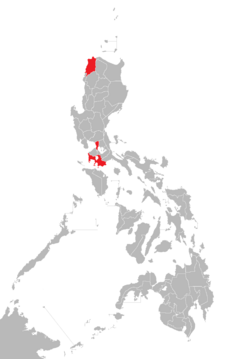
The 1899 Constitution of the Philippines created the President of the Council of Government. This person was in charge of the President's secretaries and managed the government's daily work. Apolinario Mabini, the first to hold this role, also served as the foreign affairs minister.
The 1973 Constitution clearly outlined the powers of the Prime Minister, especially during Ferdinand Marcos's time. To become Prime Minister, a person had to be a member of the Interim Batasang Pambansa. The Prime Minister could not be removed from office through impeachment, meaning they could serve for an unlimited time. However, the Batasang Pambansa could choose a new Prime Minister by a majority vote.
The Prime Minister also led the Cabinet, a group of top government officials. They could appoint and remove Cabinet members.
Other important duties included:
- Choosing a deputy prime minister to help with duties.
- Presenting the government's plans to the National Assembly.
- Overseeing all government ministries.
- Leading the Armed Forces of the Philippines as their commander-in-chief.
- Appointing leaders of government offices and promoting military generals.
- Granting pardons and amnesties with the National Assembly's approval.
- Guaranteeing loans for the country.
In 1981, the 1973 Constitution was changed. Many of the Prime Minister's executive powers were given back to the President. The President became directly elected by the people and had full control over the ministries. The President also decided national and foreign policies and commanded the armed forces. The Prime Minister still led the Cabinet but mainly supervised the ministries. The President nominated the Prime Minister, who was then elected by the Batasang Pambansa.
In 1981, the Prime Minister's powers were expanded to oversee ministries more closely. The Prime Minister was in charge of the government's daily operations and coordinating ministries. In 1984, the Prime Minister also led a special committee that helped the President.
Insignia
The Prime Minister had an official seal. It was used on reports and displayed in their office. The seal had a white triangle with special Baybayin letters, possibly meaning "Prime Minister." It was surrounded by rays and three stars, all inside a blue circle. This was then inside a white ring with the words "SEAL OF THE PRIME MINISTER" and "PHILIPPINES." The Prime Minister's flag was yellow with this seal in the middle.
Office
The Prime Minister's offices were located in the Executive House in Manila. This building was once called the Legislative Building.
List of Prime Ministers
| No. | Portrait | Name
Constituency |
Term | Party | Election | Legislature | President | |
|---|---|---|---|---|---|---|---|---|
| 1 |  |
Apolinario Mabini (1864–1903) |
January 2, 1899 – May 7, 1899 (125 days) |
Nonpartisan | 1898 | Malolos Congress | Emilio Aguinaldo | |
| 2 | 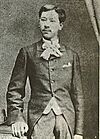 |
Pedro Paterno Delegate from Ilocos Norte (1857–1911) |
May 8, 1899 – November 13, 1899 (189 days) |
Nonpartisan | ||||
| Office abolished (November 13, 1899 – January 17, 1973) | ||||||||
| Office vacant (January 17, 1973 – June 12, 1978) | ||||||||
| 3 | 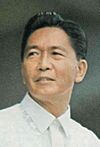 |
Ferdinand Marcos (1917–1989) |
June 12, 1978 – June 30, 1981 (3 years, 18 days) |
KBL | 1978 | Interim Batasang Pambansa | Ferdinand Marcos | |
| 4 | 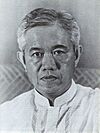 |
Cesar Virata MP for Region IV; Cavite (born 1930) |
July 28, 1981 – February 25, 1986 (4 years, 212 days) |
KBL | ||||
| 1984 | Regular Batasang Pambansa | |||||||
| 5 | 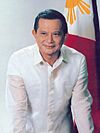 |
Salvador Laurel (1928–2004) |
February 25, 1986 – March 25, 1986 (28 days) |
UNIDO | Corazon Aquino | |||
| Position abolished (since March 25, 1986) | ||||||||
Timeline of Prime Ministers

Deputy Prime Minister of the Philippines
| Deputy Prime Minister of the Philippines | |
|---|---|

|
|

Coat of arms of the Philippines (1985–1986)
|
|
|
|
| Style | Deputy Prime Minister (informal) The Honorable (formal) His Excellency (formal, diplomatic) |
| Member of | Cabinet |
| Nominator | The President |
| Appointer | Batasang Pambansa |
| Precursor | Office established |
| Formation | June 12, 1978 |
| First holder | Cesar Virata |
| Final holder | Jose Roño |
| Abolished | March 25, 1986 |
The Deputy Prime Minister of the Philippines was the second-highest leader in the Philippine government from 1978 to 1986. This person helped the Prime Minister and took over their duties when the Prime Minister was away. The Deputy Prime Minister could also answer questions from lawmakers in the Batasang Pambansa.
After changes to the 1973 Constitution in 1981, the President could choose a Deputy Prime Minister from the members of the Batasang Pambansa. Before this, the President could choose as many deputy prime ministers as needed.
Only two people held this position before it was removed along with the Prime Minister's role. Cesar Virata was the first Deputy Prime Minister, serving from 1978 to 1981. He also served as finance minister under President Marcos. Virata is the only person who was both a Deputy Prime Minister and later a Prime Minister.
The last Deputy Prime Minister was Jose Roño. He also served as the minister of local government. The position was removed on March 25, 1986, when the "Freedom Constitution" was put in place.
List of Deputy Prime Ministers
| No. | Portrait | Name Constituency (Lifespan) |
Term | Party | Cabinet | |
|---|---|---|---|---|---|---|
| 1 |  |
Cesar Virata MP for Region IV (b. 1930) |
June 12, 1978 – July 28, 1981 (3 years, 46 days) |
KBL | Marcos | |
| 2 |  |
Jose Roño MP for Region VIII; Samar (1923–2003) |
July 28, 1981 – March 25, 1986 (4 years, 240 days) |
KBL | Virata | |
| Laurel | ||||||
| Position abolished (since March 25, 1986) | ||||||
Statistics
- Living former prime minister:
- Cesar Virata (1981–1986) (born December 12, 1930) — 95 years, 7 days
- List of prime ministers by age at the start of term:
-
- Ferdinand Marcos — 60 years, 274 days
- Salvador Laurel — 57 years, 99 days
- Cesar Virata — 50 years, 200 days
- Pedro Paterno — 41 years, 69 days
- Apolinario Mabini — 34 years, 163 days
- List of prime ministers by tenure of office:
-
- Cesar Virata (1981–1986) — 4 years, 240 days
- Ferdinand Marcos (1978–1981) — 3 years, 18 days
- Apolinario Mabini (1899) — 184 days
- Pedro Paterno (1899) — 131 days
- Salvador Laurel (1986) — 28 days
See also
 In Spanish: Primer ministro de Filipinas para niños
In Spanish: Primer ministro de Filipinas para niños
- List of sovereign state leaders in the Philippines
- Vice President of the Philippines


